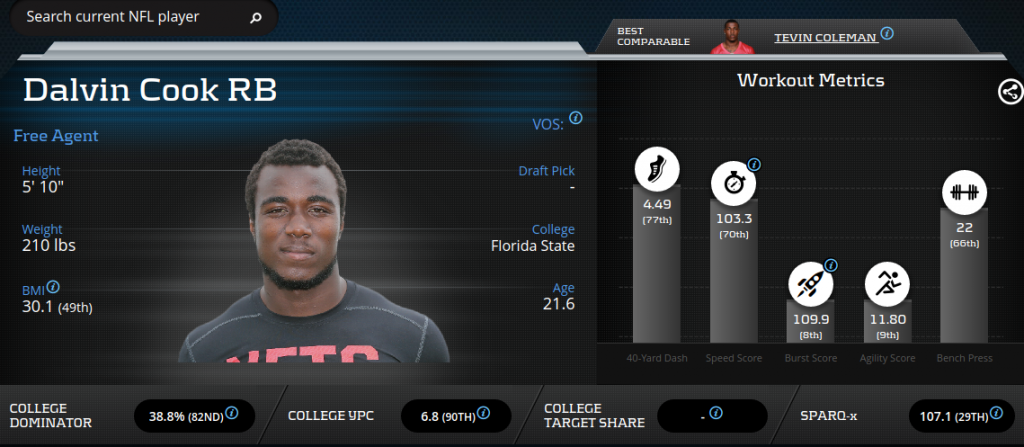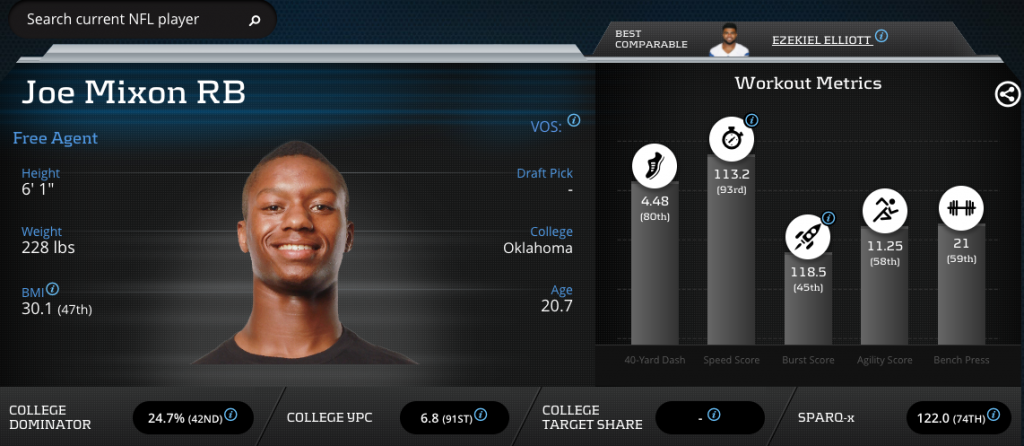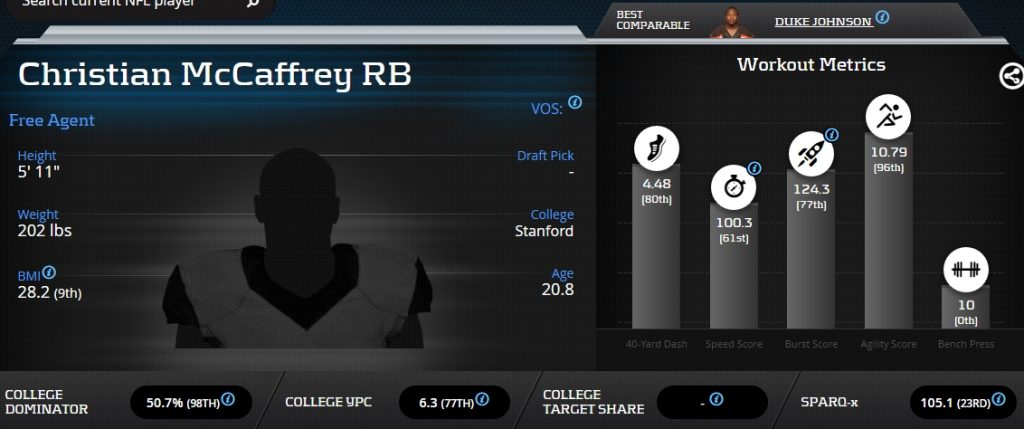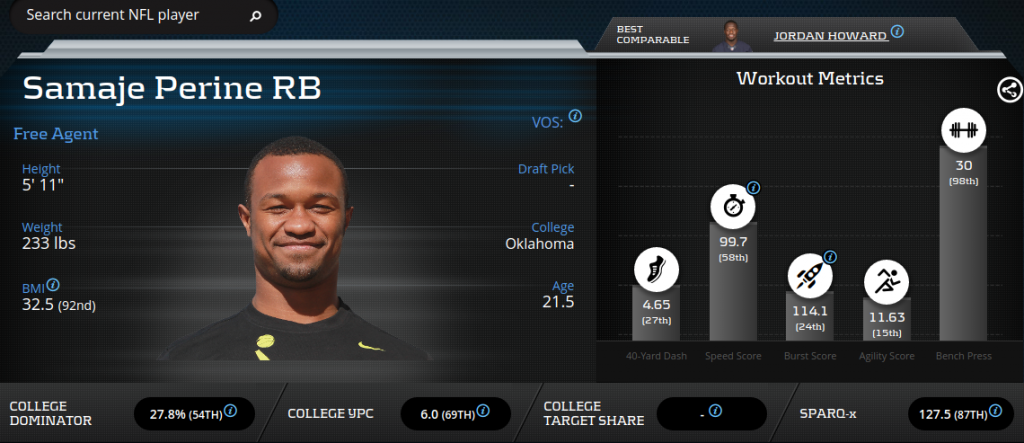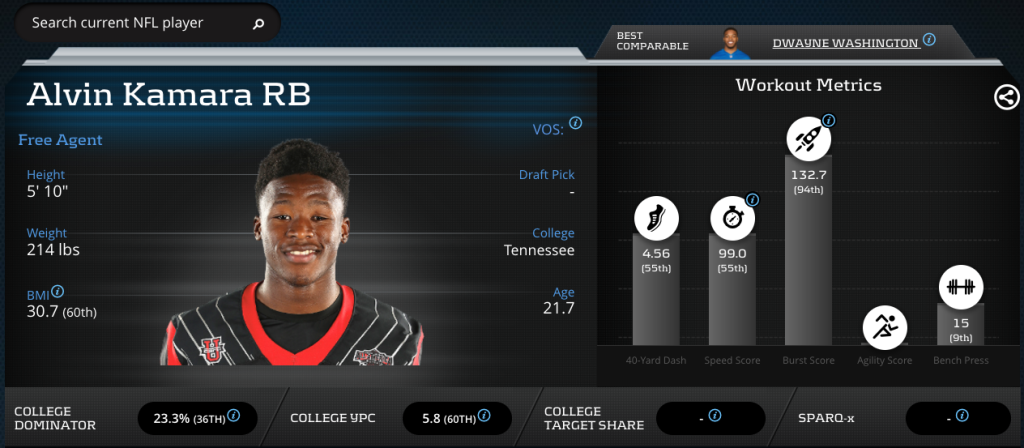This year’s running back class is the most situation-dependent class of the last 5 years. The situation a running back lands in after the draft is always important. Still, even in poor situations, we can mine for talent using metrics that give us hope should an opportunity arise. This is increasingly true as more and more NFL running backs are becoming role-players. But the 2017-class is the most unathletic since 2013 and the qualities they possess suggest a narrower path to success.
Rumors about an epic running back class in 2017 have been persistent for years. Jacob Rickrode explained the odds of rookie draft picks hitting. So to get a sense of how this class might stack up I collected advanced metrics on every rookie since 2013 using PlayerProfiler.
They were dominant in college, and have a young Breakout Age. This is a good thing. Breakout Age is the skeleton key to unlock the potential of Wide Receivers and can be used to avoid wide reciever busts. We can apply similar logic to running backs. The 2017-class did not need experience or a size advantage to become dominant in college. But they also combine for the lowest Burst Score, Agility Score, and SPARQ-x Score over the last five years.
Rookies often take a while to develop and find opportunity. But taking a quick look at the 2013-class shows some parallels between the class averages and how they look 5 years into their careers.
Shorter with better agility and burst, the 2013 running back class was relatively stocked with quality satellite backs: Giovani Bernard, Theo Riddick, Andre Ellington, and Chris Thompson. It also brought us Le’Veon Bell, a true generation every-down running back, and Latavius Murray, a 6-2 straight-line grinder. Zac Stacy, and Montee Ball both left the league soon after flaming out as primary backs. C.J. Anderson and Spencer Ware found some success in and out of the receiving game, but their roles and job security are uncertain.
Averages are not projections of a whole class or every prospect, but the deficiencies and efficiencies show up as the dust settles.
The 2017-class scored lower in more areas that matter for predicting success for running backs in football – according to Kevin Cole’s Running Back Decision Tree – apart from 40-time. We like fast players and good Height Adjusted Speed Scores, but we prefer them paired with something like Height and/or Athleticism.
The Rookie Report series on PlayerProfiler have done a great job highlighting the potential for prospects in this draft in the much broader context of college production. But noticeable trends of low Agility Scores and Burst Scores are clear. Being fast and relatively short does not make a satellite back. The archetypes of this class are not the more all-around athletes of 2013. There YPC does offer the potential of experience, but their lack of Agility means they are unlikely to catch on as this type of role-player.
Dalvin Cook, Florida State
Dalvin Cook‘s 11.80 (9th-percentile) Agility Score aligns with only a handful of successful running backs: Eddie Lacy (11.77), Isaiah Crowell (11.84), and C.J Prosise (11.80).
Dalvin Cook‘s may be an exception in the receiving game at least. His most comparable player on PlayerProfiler is Tevin Coleman, who did great things in the receiving game during the 2016 season. This comparison makes perfect sense based on their Speed Scores and a high-level college production that works in Cooks favor. Since Coleman did not post an Agility Score or Burst Score it’s hard to disagree. There are other roles to play, but they are generally less efficient for fantasy football and often more replaceable. But there again we have reasons for concern based on their lack of explosiveness.
Joe Mixon, Oklahoma
Joe Mixon‘s 113.2 Speed Score (91st-percentile), a 11.25 Agility Score (58th-percentile), and 118.5 Burst Score (45th-percentile) combines to illustrate the best all-purpose running back profile in the 2017 NFL Draft running back class.
Christian McCaffrey, Stanford
Christian McCaffrey is the opposite of enigmatic with one of the highest Agility Scores ever recorded and fantastic college production as a receiver and runner. An impressive all-around profile, lacking only in strength he draws comparisons to Danny Woodhead and Duke Johnson.
Leonard Fournette, LSU
Despite being flawed, he has a clear path to use in the NFL and Leonard Fournette has college production to back it up. Although his overall athleticism indicates he is a lesser talent than Derrick Henry, Fournette will undoubtedly start 2017 in a primary back role.
https://www.youtube.com/watch?v=vzou_kDRGoc&t=20s
Jeremy McNichols, Boise State
There are less-enigmatic prospects to get excited about. They defy the low-agility and low overall athleticism trends of 2017 NFL Draft class. Jeremy McNichols offers a more well-rounded all-purpose skill set, but is still a raw inside runner.
https://www.youtube.com/watch?v=gkUr4IcrTZ0&t=5s
Samaje Perine, Okahoma
Samaje Perine is strong and every bit a power running back but with a 24th-percentile Burst Score he has no explosiveness to go along with his poor 15th-percentile Agility Score.
Jamaal Williams, BYU
Despite a highly productive college career Jamaal Williams‘ Agility and Burst Score are so unsettling that he projects as a career backup but with some upside.
https://www.youtube.com/watch?v=ShFNKTTGOV0
Joe Williams, Utah
Joe Williams sparks some interesting comps but his lack of production in the passing game and poor Agility Score indicate he is an early-down grinder at best.
Alvin Kamara, Tennessee
Another potential outlier; Alvin Kamara is more explosive than the majority of running backs, in any class, with a 94th-percentile Burst Score. This makes for improbable, but impressive potential.
Outside of a few prospects, the class lacks agility, burst and athleticism; making it hard to imagine a great opportunity for success. The hope is that the 2017 NFL Draft will place this running back class will make up for its shortcomings by leveraging a relatively young collective breakout age, college production, and size-adjusted speed. However, given the overall deficiencies of the class, most prospects will be highly landing spot-dependent. Their post-draft offensive situations will be a more significant driver of NFL success than previous years.



